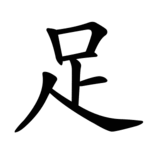Radical 157
Chinese character radical From Wikipedia, the free encyclopedia
Chinese character radical From Wikipedia, the free encyclopedia
Radical 157 or radical foot (足部) meaning "foot" is one of the 20 Kangxi radicals (214 radicals in total) composed of 7 strokes.
| 足 | ||
|---|---|---|
| ||
| 足 (U+8DB3) "foot" | ||
| Pronunciations | ||
| Pinyin: | zú | |
| Bopomofo: | ㄗㄨˊ | |
| Wade–Giles: | tsu2 | |
| Cantonese Yale: | juk1 | |
| Jyutping: | zuk1, zeoi3 | |
| Japanese Kana: | ショク shoku / ソク soku (on'yomi) あし ashi / たる taru (kun'yomi) | |
| Sino-Korean: | 족 jok | |
| Hán-Việt: | túc | |
| Names | ||
| Chinese name(s): | (Left) 足字旁 zúzìpáng (Bottom) 足字底 zúzìdǐ | |
| Japanese name(s): | 足/あし ashi (Left) 足偏/あしへん ashihen | |
| Hangul: | 발 bal | |
| Stroke order animation | ||
 | ||
In the Kangxi Dictionary, there are 580 characters (out of 49,030) to be found under this radical.
足 is also the 158th indexing component in the Table of Indexing Chinese Character Components predominantly adopted by Simplified Chinese dictionaries published in mainland China.
| Strokes | Characters |
|---|---|
| +0 | 足 |
| +2 | 趴 |
| +3 | 趵 趶 趷 趸SC (=躉) |
| +4 | 趹 趺 趻 趽 趾 趿 跀 跁 跂 跃SC (=躍) 跄SC (=蹌) |
| +5 | 跅 跆 跇 跈 跉 跊 跋 跌 跍 跎 跏 跐 跑 跒 跓 跔 跕 跖 跗 跘 跙 跚 跛 跜 距 跞SC (=躒) 践SC (=踐) |
| +6 | 践JP (=踐) 趼 跟 跠 跡 跢 跣 跤 跥 (=跺) 跦 跧 跨 跩 跪 跫 跬 跭 跮 路 跰 跱 跲 跳 跴 跶SC (=躂) 跷SC (=蹺) 跸SC (=蹕) 跹SC (=躚) 跺 跻SC (=躋) |
| +7 | 跼 跽 跾 跿 踀 踁 (=脛 -> 肉) 踂 踃 踄 踅 踆 踇 踈JP (=疏 -> 疋) 踉 踊SC (=踴) 踋 踌SC (=躊) 踍 踎 |
| +8 | 踏 踐 踑 踒 踓 踔 踕 踖 踗 踘 (=鞠 -> 革) 踙 踚 踛 踜 踝 踞 踟 踠 踡 踢 踣 踤 踥 踦 踧 踨 踩 踪SC/JP (=蹤) 踬SC (=躓) 踭 踮 踯SC (=躑) 踺 |
| +9 | 踫 (=碰 -> 石) 踰 (=逾 -> 辵 / 窬 -> 穴) 踱 踲 踳 踴 踵 踶 踷 踸 踹 踻 踼 踽 踾 踿 蹀 蹁 蹂 蹃 蹄 蹅 |
| +10 | 蹆 蹇 蹈 蹉 蹊 蹋 蹌 蹍 蹎 蹏 (=蹄) 蹐 蹑SC (=躡) 蹒SC (=蹣) 蹓 |
| +11 | 蹔 (=暫 -> 日) 蹕 蹖 蹗 蹘 蹙 蹚 蹛 蹜 蹝 蹞 (=跬) 蹟 (=跡) 蹠 (=跖) 蹡 蹢 蹣 蹤 蹥 蹦 蹧 (=糟 -> 米) 蹮 躀 |
| +12 | 蹨 蹩 蹪 蹫 蹬 蹭 蹯 蹰SC (=躕) 蹱 蹲 蹳 蹴 蹵 (=蹴) 蹶 蹷 蹸 蹹 蹺 蹻 蹼 蹽 蹾 蹿SC (=躥) |
| +13 | 躁 躂 躃 躄 躅 躆 躇 躈 躉 |
| +14 | 躊 躋 躌 (=䟼) 躍 躎 躏SC (=躪) |
| +15 | 躐 躑 躒 躓 躔 躕 躖 |
| +16 | 躗 躘 躙 躚 躛 躜SC (=躦) |
| +17 | 躝 躞 躟 躠 |
| +18 | 躡 躢 躣 躤 躥 |
| +19 | 躦 躧 |
| +20 | 躩 躪 |
| +21 | 躨 |
The radical is also used as an independent Chinese character. It is one of the Kyōiku kanji or Kanji taught in elementary school in Japan.[1] It is a first grade kanji[1]
Seamless Wikipedia browsing. On steroids.
Every time you click a link to Wikipedia, Wiktionary or Wikiquote in your browser's search results, it will show the modern Wikiwand interface.
Wikiwand extension is a five stars, simple, with minimum permission required to keep your browsing private, safe and transparent.